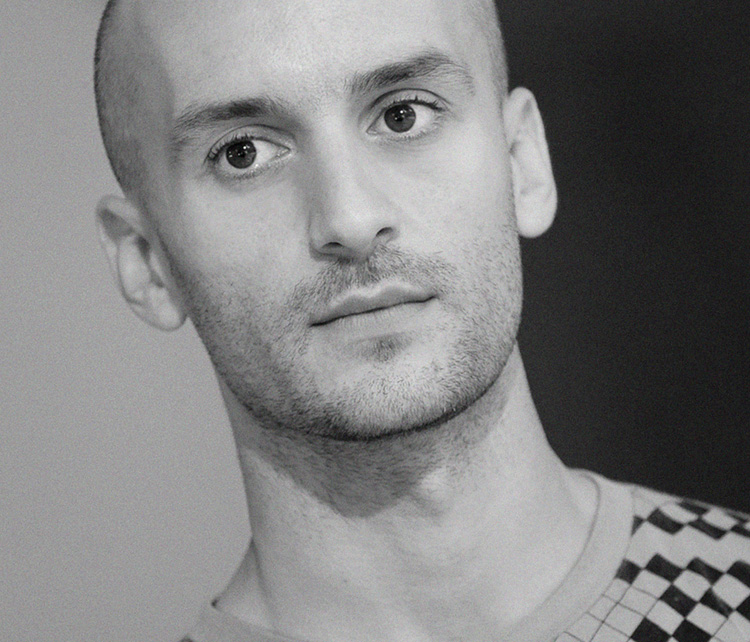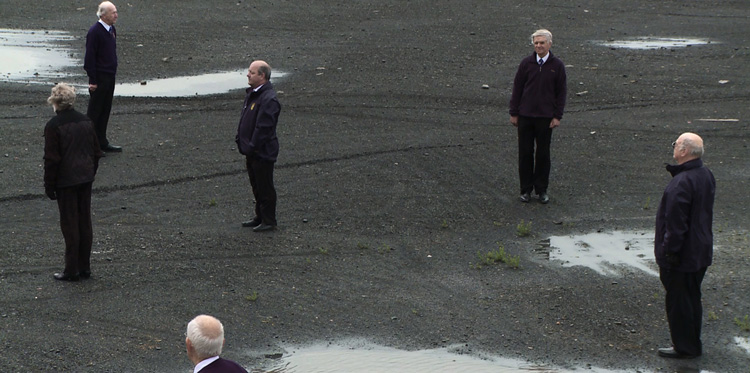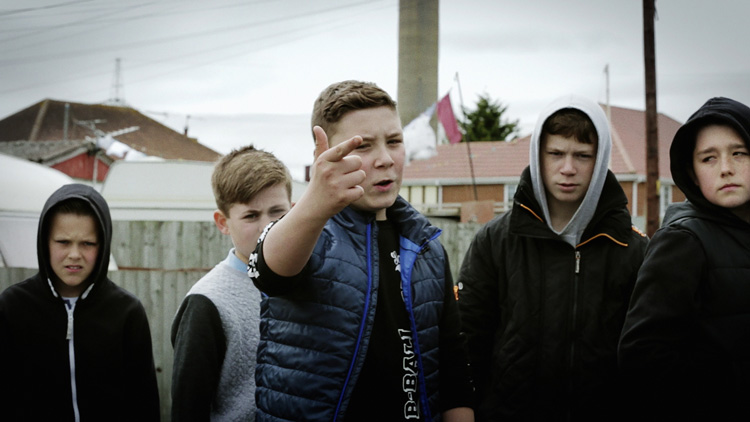

by ELIZABETH FULLERTON
In a world so divided and fractious, what can we learn from those sections of society with almost no political voice, such as people with disabilities, children and the jobless? This question underlies the videos, installations, performances, sound works and images of the British-Greek artist Mikhail Karikis (b1975, Thessaloniki), whose practice centres on close collaborations with marginal communities and has a strong focus on sound and voice. Listening is a fundamental theme in Karikis’s solo exhibition I Hear You, at the De La Warr Pavilion in Bexhill-on-Sea, Sussex.
[image16]
Co-commissioned by the De La Warr and Project Art Works, an artist-led organisation in Hastings devoted to people with complex support needs, Karikis’s project homes in on the overlooked and undervalued role of the carer, through five powerful video portraits. What is so striking about these short films is the patience, dedication and respect each carer demonstrates for their charges. Much of the communication of the cared-for people is non-verbal, consisting of grunts, whines, whistles and gestures, yet there is a clear bond of understanding that is profoundly moving and, importantly, non-hierarchical. This is care in the purest sense. In Doreen + Carl, for instance, Doreen concentrates intently on her son Carl, whom she hugs repeatedly, and affirms his yelps and gabbling with smiles and phrases such as “good man”. Paul + Dan demonstrates the easy companionship between Paul and his carer of 12 years, Dan, who is one of his two round-the-clock support workers. These works propose a re-evaluation of our narrow, “abled” definition of communication. They call to mind the autism activist Amanda Baggs’s groundbreaking 2007 YouTube video In My Language, in which she says:“My language is not about designing words or even visual symbols for people to interpret. It is about being in a constant conversation with every aspect of my environment.”
[video1]
Mikhail Karikis. No Ordinary Protest, 2018 (trailer).
Karikis’s films seek to empower marginal communities by helping them to represent themselves. In the captivating film No Ordinary Protest (2018), co-commissioned by the Whitechapel Gallery and Middlesbrough Institute of Modern Art (Mima), the artist worked with children at an east London primary school to unpack an eco-feminist fable, The Iron Woman by Ted Hughes. Using sounds, instruments and unnerving neon-look masks, the children enacted their response to the environmental crisis, displaying a wisdom beyond their years.
[video2]
Mikhail Karikis. Ain’t Got No Fear, 2016 (trailer).
For his 2016 film Ain’t Got No Fear, Karikis invited teenagers from the economically deprived Isle of Grain in Kent to compose and perform a rap about their lives, hopes and anxieties. His video installation SeaWomen (2012) documents a matriarchal society of elderly Korean pearl divers, who produce animal-like sounds as a breathing technique when they brave the watery depths. Invisible labour, the ecology and the negative effects of technology on human lives are central motifs threading through Karikis’s oeuvre.
This is a big moment for Karikis. Besides the De La Warr show, he is a contender for this year’s Jarman Award, has a survey exhibition, For Many Voices, opening next month at Mima, and Tate St Ives is showing Children of Unquiet (2014), filmed in a volcanic region of Tuscany with children whose parents have been made jobless by automation of the local power plant.
Elizabeth Fullerton: For your De La Warr show, you spent the best part of a year at the Project Art Works studios. What prompted you to focus on the carers?
Mikhail Karikis: I was puzzled by the fact that they would come with the person they look after and just be there. To someone who doesn’t pay close attention, they would think the carer does nothing, sits there and waits. Progressively, I started really noticing everything the support workers do, which is not very visual. They engage with an invisible sense, hearing. I was fascinated by the fact that their entire body language would tune into every sound or facial expression of the person they cared for. That sometimes happened remotely. This is how I got the idea, actually. There was one particular support worker upstairs and I saw him suddenly sit straight, and you could see that he was not with us any more; he was absent. His whole being was invested in just listening to the range of sounds that the person he cares for was producing, and that person was downstairs. It’s what parents do when they have a newborn baby, but this is what carers do all the time. They don’t switch off, it’s incredible. It must be absolutely exhausting. This is what I found absolutely moving.
I felt there aren’t really any portraits of people who are support workers. Usually, when we think of people with disabilities, we think of them and the state that funds them.
[image3]
EF: The carers are so compassionate and attentive in the videos. It is a real gift.
MK: For me the core of the project is about communication. There’s interest because they have to be interested in what the other person is trying to communicate. There’s risk-taking because very often you don’t know what the other person is able to perceive because their nervous system is wired in a different way. You have to push the communication to a certain degree, but so that it doesn’t compromise, offend or unsettle the other person. There’s also a generosity that is a really essential component of communication. You have to be open enough to receive whatever the other person sends your way and interpret it. The process of socialisation and the introduction of language has a very specific structure that conditions us to think and communicate in a specific way, but it closes the other channels. I think we are innately able to communicate and this is why I feel that the project has a strong political resonance, especially now that opinions are so polarised. I think that, just by looking at carers and observing how they approach communication, we can learn a vast amount about it.
EF: To what extent do you see your work as indirect activism?
MK: All my work is indirect activism. I see myself as someone who facilitates and creates the right conditions for people’s voices to be heard. The work is a kind of catalyst for other people’s points of view, states of being, to become visible, audible. There are specific dominant narratives that give people labels – for example, if they’ve lost their jobs – but how do they present themselves, if given the chance to create a self-portrait?
[image14]
EF: This series of video portraits seems to have a more documentary feel in contrast to your previous collaborative projects. Would you agree?
MK: I don’t know the difference between the two. I’m going to describe what I would do during the day that would lead to filming. Prior to going to Hastings, I would have exchanged emails with the carer, whom I had already known for several months. We would spend from 9.30am till 3pm having tea, talking about different things. Then I would ask if this was a good time to film and usually I would film for 20 minutes, but that again would have to be in negotiation with the person with the disability. There would be a lot of planning to do with when they put the camera in, where everybody was sitting, and then I would go in and have to somehow reach a state of consciousness that was almost equal to – I don’t know what other metaphor to give you – the hum of the ventilator. I had to be present and in tune with what was happening, but at the same time completely invisible. Everything was handheld, I was doing all the sound and camera myself. It was impossible to introduce someone else into that very intimate setup. Anything else would unsettle it.
[image4]
EF: It sounds extraordinarily intense.
MK: The process of filming was the most emotional experience I’ve had during work, ever. Ever. I have never cried during filming until this project. I felt I was observing something that was so precious, so intimate, so generous that I could not believe my luck that I was witnessing this: that both the person with the disability and the carer were generous enough to allow me to witness those very intimate exchanges. Usually these are invisible.
EF: It was so poignant to observe how the carers treated their charges with such dignity, as equals.
MK: I think it’s the quietest work I’ve ever made. It has no artifice and no spectacle compared with other works that have cinematographic elements that I like exploring, from the colour of the light to costume, masks and choral sound-making, composed sound. This one is quite ascetic, very pared back in terms of its aesthetic complexity, but at the same time I personally feel it’s my most mature work.
EF: What are the most important lessons you learned from the project?
MK: This project features quite unlikely dialogues between language and non-language. Or rather, it’s a more expanded form of language that incorporates noise-making, whistling, gestures, laughing, shouting, sounds that we might find disturbing. It’s about acknowledging that there’s so much we don’t know and so much we can learn from people who have complex needs simply because they’re wired in a completely different way from a neurotypical person. To be able to communicate with a neurodiverse person gives us access to the unknown. How do they perceive the world? How can the world be understood in a different way? We have the obligation to share the world with people who are not like us and this is what the carers really give us a glimpse into. They’re showing me what I need to do in order to be more accommodating, more inclusive, more open to people who are not like me.
EF: How does this project connect to your other work?
MK: I had a moment of realisation after I finished editing this work that, throughout my practice, I've been fascinated by these figures who go between realms. The carers are the interface between the world of disability and the rest of us. In Sounds from Beneath (2011-12), which was created with coal miners, they’re survivors who went to the edge of existence. They worked under really dangerous conditions inside the guts of the Earth and the work excavates their memories by asking them to recall the sounds that they used to make when they worked in the mines, but also it reveals the fact that, again, they’re these figures between the living and dead, between light and darkness.
[image7]
Even with SeaWomen, these Korean female pearl divers in their 70s and 80s go into a different realm and when they come up – if they’re lucky and don’t die – they come back transformed. All of these projects are about really connecting with people who are translators, who have taken a risk to access a realm that the rest of us haven’t been to.
EF: Those projects dealt with adults, but several of your films have been collaborations with children. What drew you to work with them?
MK: It came after a string of works with people who were retired or at a later stage of their lives and those works were dealing with issues of vanishing forms of labour, post-industrialisation and the negative consequences of that. And although it was joyous to work with that generation, I ultimately felt quite heavy. I wanted to see the legacies that these generations and my own are leaving behind through the perspective of young people. If there is a narrative of ecological disaster, how do we communicate that in a way that is not debilitating to younger people and how do they imagine the future?
[image8]
There is no space in our theoretical, political discourse that accommodates the voices of children and teenagers and makes them part of decision-making and I think it’s not fair. What I’m discovering is that, if we really make space for those voices, we will see hope because they are seeing the same problems in a completely different way. By rendering children, teenagers and disabled people inaudible, our society is missing out on these other diverse points of view that can often be more positive.
EF: One of our basic cultural references for children seems to be William Golding’s disquieting novel Lord of the Flies. Why do adults find them so threatening?
MK: I’m very consciously playing with that. Children demand to be heard and we can’t take our eyes away. We have to watch them. Our fear probably comes from the fact that, until they reach a certain age, children are not so aware of consequences, but this is the aspect of working with children that I absolutely adore. They test my limits and there’s something about the intensity of feeling when children express anger or happiness that seems to have cosmic dimensions; it seems so much larger than their bodies. I think it lends a kind of dynamic in the work I’ve done with children. There’s this capsule of potential energy that can go in different directions.
[image9]
EF: For example?
MK: With No Ordinary Protest, we were exploring different scenes from The Iron Woman, Ted Hughes’s sequel to The Iron Man, and some of the children’s questioning was incredible. They were trying to understand what, not who, is the Iron Woman, who made her, whether she was human or machine. There’s a moment where they are debating whether humans are animals and a girl says: “That question has no wrong or right way. We’re a type of animal, but we are different than how we think animals are.” So this seven-year-old girl is able to articulate all the ontological philosophy to do with the construct of difference and the fact we have created a category called animals to differentiate ourselves from them. I realised in these projects that, if you create the right conditions for children to ask questions and exchange ideas, they can be incredibly wise. I was so moved.
EF: Is part of your motivation in working with children to make amends for some of the damage our own generation has inflicted on the planet?
MK: Certainly. I do feel a degree of shame that my generation is handing to younger generations these legacies of pollution, unjust political authoritarian systems and so on. I can’t relate to these aspects of my generation. I’m a lot more invested in trying to contribute and connect with the younger generation in a more positive way and, hopefully, give them tools that will enable them to deal with this mess.
[image10]
EF: All your films incorporate a range of sounds. In No Ordinary Protest and Children of the Unquiet, the children hiss, hum, buzz, whistle, chant and make a range of indescribable noises. What is the special appeal of sound to you?
MK: Sound travels to you. It’s not like observing a painting, where there is a distance between the viewer and the work. When I work with sound, I’m always thinking of it in a sensory way, the fact you are bathed in the medium and that it will penetrate the bodies of the people experiencing it. I’m also interested in how sound can oscillate between meaning and meaninglessness: the same with the voice, its flexibility to oscillate between making sense and creating nonsense and how that affects the listener. I think we have an instinctive terror towards voices that are inarticulate or that produce nonsense. There’s also something fundamentally uncanny about onomatopoeia and mimicking voices. It creates a lot of complexity in how we read the self and our relationship to the world. Sound has this innate ability to disrespect boundaries and take risks.
EF: In what sense does it take risks?
MK: The philosopher Hannah Arendt wrote that, in order for citizens to be political citizens, they need to be visible in the public realm. I agree with that, but my question is, what happens to all those citizens who are not visible? Could sound and paying attention to what might be audible, or just about audible, give me another way to understand the political? If the visible presents a specific kind of hierarchy – and it does – of who receives more visibility than someone else, could thinking through sound and working with sound make me expose different kinds of hierarchies and somehow subvert the relationship between who is visible and who is audible?
EF: This reasoning presumably relates to the shift in your work over the past decade, from merely involving participants to collaboration?
MK: I started as a performer, making sound works. I was composing and professionals were performing with me. After a while, I felt that I was expecting a bit more from myself in terms of my social and political engagement. I didn’t want to be the sole generator of works. I wanted them to be created in a more dialogical way and to go beyond the arts community. It’s what I can do to contribute towards creating a society that is fairer and provides democratic visibility to certain sections. I respect people who have a studio practice, but I would feel disconnected from the social if I did that. I see connecting with the world as my studio. I need to be in the context where the caretakers look after people who have complex needs, I need to be in the school working with the children. I need to be there.
• Mikhail Karikis: I Hear You is at De La Warr Pavilion, Bexhill-on-Sea, East Sussex, from 28 September 2019 to 19 January 2020; For Many Voices will be at Middlesbrough Institute of Modern Art from 12 October 2019 to 2 February 2020; and Children of Unquiet is at Tate St Ives until 5 January 2020.

_1.jpg)
-flat.jpg)
.jpg)
-flat.jpg)
,-production-photograph-2.jpg)

-prodction-photograph-3-(n).jpg)
.jpg)
-video-still-5.jpg)
-detail-1.jpg)


-16.jpg)
-17.jpg)